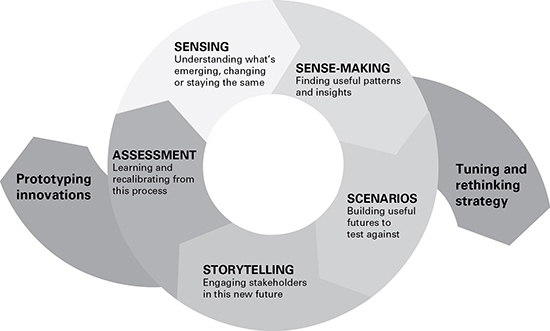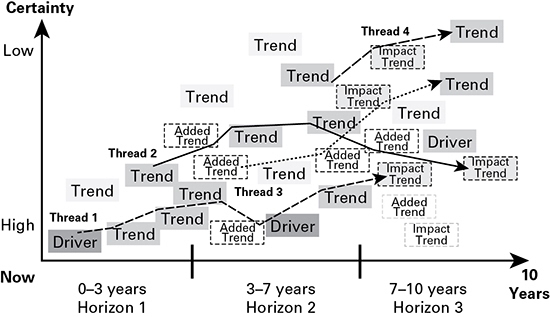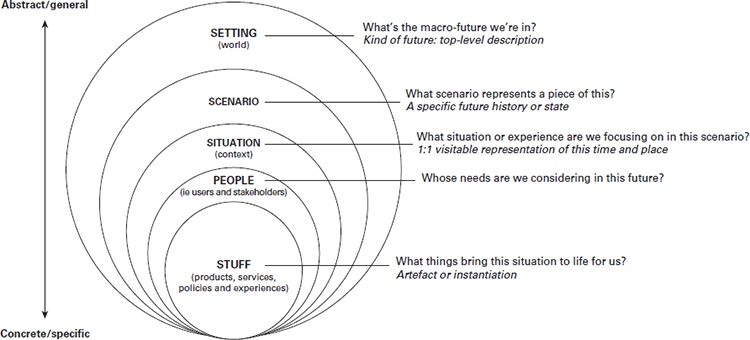
How To Future
Leading and Sense-making in an Age of Hyperchange
by Scott Smith, Madeline Ashby
Read Status: Completed 📕
Last tended 3 years ago
Planted 4 years ago
Evergreen 🌳
Tags: FUTURING
8 min read ☕️
Table of Contents
Summary
How to Future outlines a structured and detailed framework for engaging in futuring projects. Futuring is about understanding the landscape of potential futures in such a way as to guide better decision making in the present. Futuring may seem like an abstract concept to a layperson, but the results of futuring can be observed everywhere in our lives. For example, Moore's law is a good example of futurology.
How to Future is a project of Changeist.
How I Discovered It
It was by coincidence. I was looking for another book with a similar title, this book appeared top on the list instead. The rating was high at 4.1, which is rare. Interestingly, the authors started writing this book in Singapore, a city they describe as a place with "signature futuristic architectural lines, green buildings and blue-lit trees" and embraces "a future-present and future-future simultaneously". Singapore is also the city I grew up in and one of the filming locations for Westworld, a popular sci-fi drama.
Who Should Read It
Anyone who is interested in the field of futuring. This book is designed to equip people of different backgrounds, needs and contexts with mindsets, tools and practices for better understanding of possible futures and their impacts.
Podcast
Listen to the author talk about ideas from the book.
Click here for similar podcasts from other authors from my resonance library.
Key ideas
Introduction to Futuring
Future is a process not a destination.
The idea of future is hot. We are constantly bomdarded by messages that is looking to "futurewash" the content; from marketing of product makers, taglines of management consultancies to professional conferences that promise to reveal the certain future of X.
There is a compression of the future into the future. When marketers describe their products as 'futuristic', it is as if the products have travelled back to us from a time in the future. It is as if future is a thing rather than a time. This has significant impact on the way the average person think of the future.
We need to reframe how we think of good leadership. Fixing a clear vision and pursuing it, regardless of changing circumstances doesn't work in a volatile world. Reactive repositioning merely leaves an organization to respond defensively.
We tend to think in time frame as we grow older. As children, we think in simpler and shorter time frames. As we grow older, we are exposed to more framings of time. Work weeks, financial quarters, billing cycles and so on.
Different cultures and faith traditions consider time differently. It is more common in North American or North European cultures to think of time as linear progression from the past to future. Other cultures see time as cyclical. Researchers refer to them as monochronic and polychronic cultures. It is important to acknowledge these differences as they can influence one's framing of possibility, probability and causality.
Tracking the future is a passive activity. We pay an insurance provider to worry about our future. We elect people into the government to plan our future.
There is an inverse relationship between the level of concern about the future and anyone's level of focus - if there is too much information or disorder, we tend to shut it off. For example, initially we might be very concerned about the rising cases of COVID-19 cases. However, once it has gone over a certain treshold, it is as if our concern for the case numbers has magically decreased.
The Futuring Process

Framing and Scoping
Good framing makes or breaks any futuring exercise. ... Good framing is the act of future-proofing your own future-proofing and ensures an appropriate lifespan of value.
Good framing is a research investment. It is about setting boundaries, choosing practices and most importantly, being aware of the considerations and reservations of the stakeholders in a futuring project. In my opinion, this chapter covers the general considerations for consultants offering any consulting services and advice for mitigating softer issues of project management to meet the final deliverables.
- Find out the reasons behind why a particular project is required
- What is your role in the project? Are you offering a turnkey solution? Or perhaps your role is to faciliate?
- Consider the source of funds into this project. It tells you how the outcome is valued. The wider the scope of futuring, the higher the cost the project will incur.
- Take time to understand your client culture and the internal language they use. Do they deal only in certainties, or is it comfortable talking about possibilities?
- Find out where futuring sits historically within your client's organization. What was the outcomes of other futuring projects before you were engaged?
Think of futures as having dimensions: length, width and depth. ... In setting the length of a future, remember to leave enough room for meaningful change, and also to centre the aims and abilities of the client and the systemic nature of the topic.
Consider useful timescales for your project. Exploring the future of the nation across the next 50 years is useful for informing long-range roadmap to policymakers, but it may be less useful when your task is to explore particular social or cultural futures. Also consider geographic scope of your project.
Sensing and Scanning
Modern humans, like our premodern ancestors, are driven to stay aware, to take in signals – the fragments and indicators of change or stasis – or what French historian Fernand Braudel called ‘thin wisps of tomorrow’. We survive and thrive based on knowing what’s happening on our landscape of choice.
Sensing – finding new meanings, relationships, patterns and implications – is the fuel that drives the engine of futuring.
Information avoidance cuts off our ability to use sensing constructively and erodes our ability to make sense of futures to come.
The constant firehose of content from various media sources can lead to information desenitization, however, we should be wary of information avoidance. We need to practice our latent capability to collect and sort information in a useful way.
There are five qualities of people who are good at future-focused sensing.
- Active noticing; Peripheral ethnographies
- Staying with the flow
- Maintaining curiosity
- Strong insights, weakly held (Think Scout Mindset)
- Keeping a safe distance and maintain a level of objectivity
Horizon scanning is a mainstay process of futures work, defined specifically as the process of looking across the landscape to detect, identify and catalogue weak signals, trends and driving forces embedded in information and activities in the world around us. As an ongoing practice, horizon scanning allows us to build up inventories of signals and evidence to better facilitate pattern recognition, track rising and falling issues, and pay attention to important factors that may shape particular futures.
Only a minority of companies have dedicated horizon-scanning teams. There is a struggle to do horizon scanning with pace, volume and reach. Too often the task of horizon scanning reverts to an occasional task, rebooted only when there is perceived external demand.
Horizon scanning can be done as an indiviudal. For example, you can use commute time to scan interesting newsletter or a few long-read articles with the future in mind. In this way we can practice our **"future mindedness".
What are you scanning for? Signals, trends and drivers
Signals are evidence that can shed light on the future. Look for characteristics such as frequency, strength, directionality, maturity, spread. It can be a datapoint, a piece of analysis, sentiments etc.
Trends are emerging patterns of change.
Drivers are forces that shapes the future.
The signal-to-noise ratio has never been more imbalanced, and when your job is to find weak signals that point to significant change, that means working harder than ever before.
Turning Insights into Patterns and Themes
Tune, focus, view, assess, add or subtract, tune again.
Curate your collection of data through a scoping question or broader frame.
One of the most useful frameworks we’ve found is STEEP, which stands for Social, Technological, Economic, Environmental and Political.
After sorting our list of trends and drivers by STEEP category, we have a one-dimensional view. We can continue to segment the data into time horizons. For example, a 10-year future can be broken down into three smaller time horizons; short term, mid term and long term.
Another common sorting method in futuring is to assign one of the three Ps – probable (likely to happen), plausible (could happen) or possible (not impossible to happen).
We can further rank trends and drivers in terms of certainty.
Building Strategic Narratives with Patterns and Emergent Themes
Sense-making takes these collected signals and allows us to consider whether they form, continue or reshape a sequence to frame a trend, or when a combination of trends indicate a new driver.
Rough draft roadmapping is the activity to map out the future roadmap in an iterative manner. Firstly, we can add key trends and drivers on the graph, and add further trends and impact trends as we observe new developments or connections. Finally, we can link up connecting trends and drivers into threads to form a cohesive narrative.

Storytelling through Materialization
In this chapter, it covers how we can create prototypes or experiences to share a glimpse of the future to our audience in a relatable way.

We can use the Experiential Futures Ladder to help us visualize and refine artefacts of engagement.
Situations needn’t be dramatic. It could a simple interaction such as finding a parking ticket for your new mode of mobility. Bringing a familiar setting together with a new normal experience or object, in what futurist and designer Nick Foster calls ‘the Future Mundane’. As an example, we could also create an snippet of a newspaper some years in the future to deliver something unfamilar in a familiar medium
Add 'other' persona other than your ideal customer can reveal more interesting needs and expectations from a given future situation. It could include non-human personas such as AI. Don’t unintentionally limit what your future could include.
Accessing Effectiveness
To assess the impacts surfaced in your scenarios, as a next step we created an approach that looks at five ‘layers’ of an organization or group, roughly proceeding from the centre outwards: People, Knowledge, Tools, Rules and Networks.
Part of the whiplash and disruption we face in dealing with unexpected futures is a lack of useful language, outdated definitions or cultural dislocation that comes from the sudden emergence of unanticipated issues.
Building a Futuring Culture
Unlike traditional job scopes such as product management, a futurist's effectiveness can't be quantified by indicators such as number of sales or products shipped on time.
The authors proposed these guidelines as futuring metrics.
- Framing provocation: Any time you raise a future-focused question, have some implications, impacts and alternative approaches at hand. Position the future as a place where questions are asked and possibilities explored.
- Driving conversations: Look for opportunities to generate and sustain meaningful discussions about the long term. Find situations where you can represent the voice of the future in present-focused or near-future projects.
- Expanding speculation: Encourage space for speculation. Provide tools and opportunities for colleagues or constituents to play with speculative ideas, prototypes and situations. People will be more comfortable doing so when presented with specific topics to consider and when they regularly have a chance to try out their own capacity for imagination.
- Seeding agility: Expose yourself and others to small practices of futuring on an ongoing basis – at work, at home, on your commute. Imagine how the future might be different, or how we might have taken another path to get where we are. Play with combinations of trends to imagine how they might generate something new.
- Impacting future strategy/innovation/policy discussions: Appoint a ‘future representative’ to working groups or project teams, even if informally (at first). Set aside space to spell out future implications of present decisions. Consider in advance what new measurements you might use to estimate impact. Cultivate new sources of information to illuminate future possibilities and multiple paths to preferable outcomes.
- Projecting vision: Find ways to situate long-term vision alongside short-term missions. Encourage others to clarify how vision relates to strategy. Take time to occasionally re-evaluate preferred futures by paying attention to emergent issues or new trends on the radar.
- Public engagement: Find ways to talk to the public about the future. Look for opportunities to co-define what’s preferable. Take opportunities to question commonly accepted images of the future and ask how others might see them differently. Share your own knowledge about the future with people and groups outside your organization, and learn about theirs. Make it a priority to bring under-represented groups into conversations about the future. Listen.
Resources
The authors have kindly added worksheets for your next futuring project with your team. The link also includes a list of additional resources for further readings.